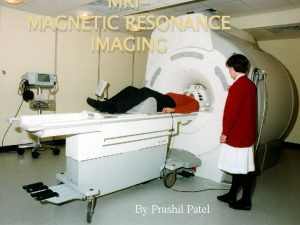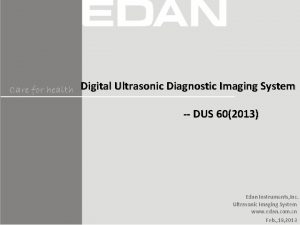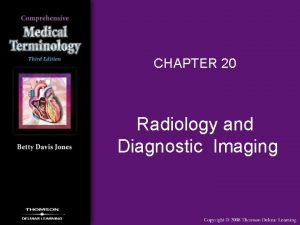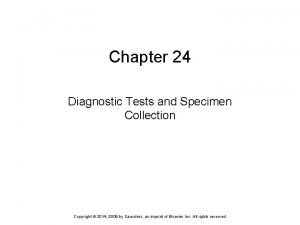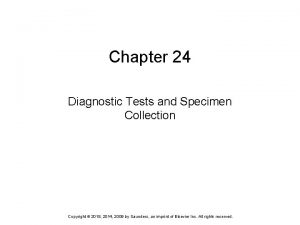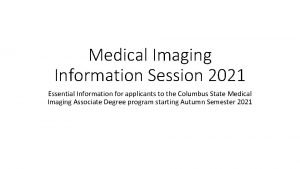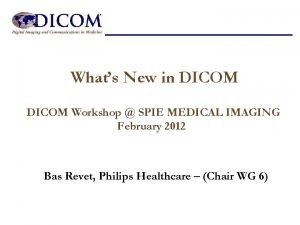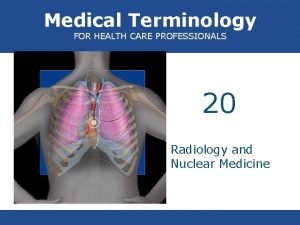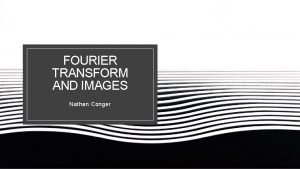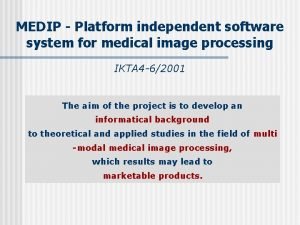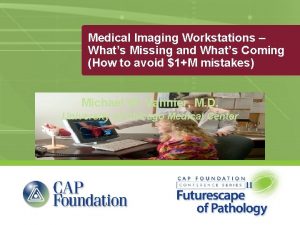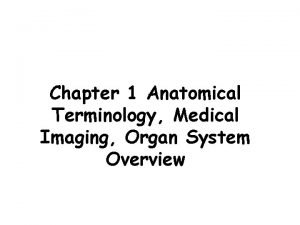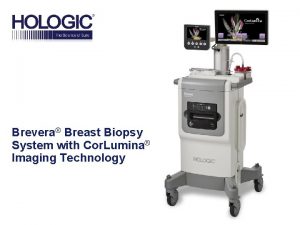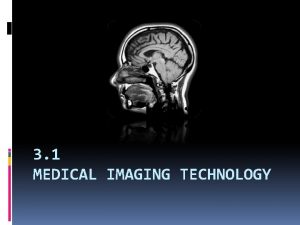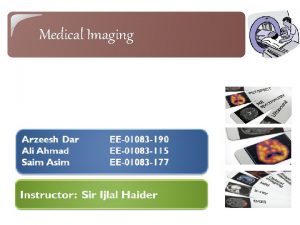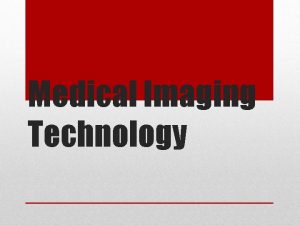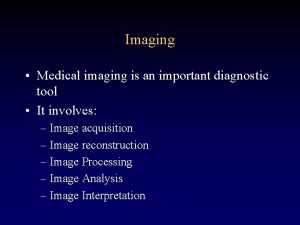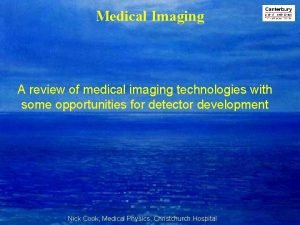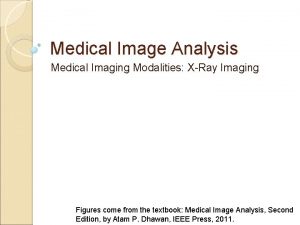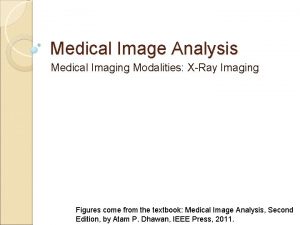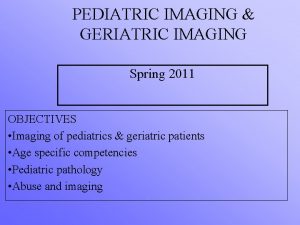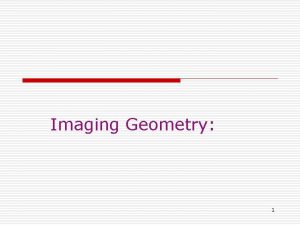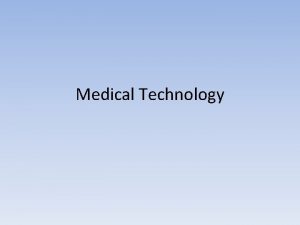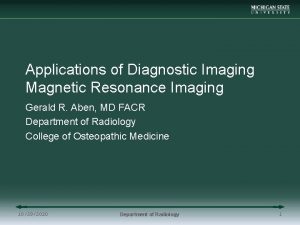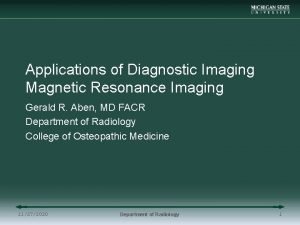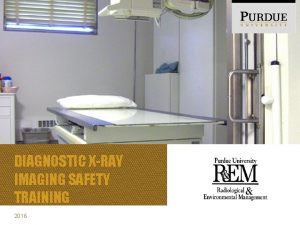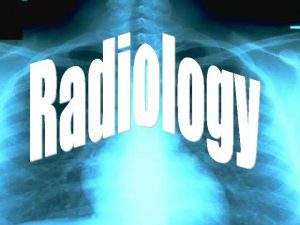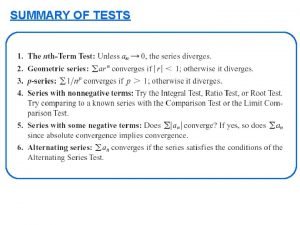MEDICAL IMAGING TECHNOLOGY Diagnostic Testing Diagnostic tests provide




































- Slides: 36

MEDICAL IMAGING TECHNOLOGY

Diagnostic Testing Diagnostic tests provide information about the structure and function of organs, tissues, and cells. Medical imaging produces images of organs and tissues within the body for use in diagnosis and treatment.

Producing Images of Organs and Tissues Medical imaging allows doctors to see within the human body so that they can diagnose and treat diseases. There are several important medical imaging technologies including X-ray, ultrasound, computed tomography (CT) scan, magnetic resonance imaging (MRI), positron emission tomography (PET), and biophotonics.

X-Ray - The most common form of medical imaging. An X-ray is high-energy radiation that can easily penetrate materials such as skin and tissues but cannot easily penetrate metals and bone. A radiograph is produced when X-rays pass through the body to produce an image. X-rays are absorbed by dense structures such as bone, the bones appear whiter than other structures


X-Ray Radiographs can be used to check for cancer and to diagnose problems in the cardiovascular and respiratory systems. Using X-rays to image the body is quick, virtually painless, and non-invasive.

X-Ray X-ray is high-energy radiation, and it can cause changes and mutations to DNA. When a radiograph is taken, parts of your body may be covered with a protective lead apron because X-rays cannot penetrate certain thicknesses of lead.

Rheumatoid Arthritis Hand X-Ray

Knee Joint X-Ray

This is why high heels hurt your feet!

X-Ray Photobomb. . .

Body Scanners Note that this is also true for the body scanners that are used at airports, especially the new “naked body scanners. ”

Body Scanners Since the radiation emitted by these body scanners is absorbed at the level of the skin, it is your skin cancer risk that is most increased – and the scans cannot find anything concealed in any body cavity. Also, like most x-rays, they do not show contrast that may be used to identify soft materials (like plastics and chemical explosives). In other words, they’re completely ineffective.

Fluoroscopy is a technique that uses a continuous beam of X-rays to produce images that show the movement of organs, such as the stomach, intestine, and colon, in the body

Fluoroscopy The patient may be required to ingest a contrast liquid, such as barium or iodine, to help the doctor see the organ clearly. Fluoroscopy is also used to study the blood vessels of the heart and the brain. The image is called an angiogram.

In a coronary angiogram, a special dye is injected into an artery in the groin. This dye enables doctors to visualize the blood flow. A cerebral angiogram shows any blockages in the blood vessels in the brain, which can lead to a stroke.

Radiotherapy In addition to using X-rays to see structures in the body, X-rays are also used to treat cancer. This type of therapy is known as radiotherapy. The X-rays damage the DNA and either kill the cancer cells or prevent them from multiplying. During radiotherapy, a beam of X-rays is directed at a tumour so that there is minimal damage to healthy normal cells. Radiotherapy may be combined with other forms of cancer therapy, including surgery and chemotherapy.

Ultrasound imaging uses high-frequency sound waves to produce images of body tissues and organs. A transducer produces the sound waves that enter the body and are reflected back to the transducer by internal body structures. This reflection makes an image of the body structure, which is recorded on a screen and viewed by a technician.

Ultrasound Can be blurred by gases Used to study soft tissues and major organs in the body as sound waves cannot penetrate bone.

2 D 3 D

Ultrasound is used during pregnancy to study the developing fetus. If an amniocentesis is required the ultrasound is used to guide the needle to the amniotic fluid to gather a sample. Amniocentesis can detect Down syndrome, cystic fibrosis, and spina bifida. Ultrasound is also used in the diagnosis of heart problems.

Computed Tomography (CT) / Computer Assisted Tomography (CAT)

Computed Tomography (CT) / Computer Assisted Tomography (CAT) Uses X-ray equipment to form a three dimensional image from a series of images taken at different angles of the body Used to diagnose cancer, abnormalities of the skeletal system, and vascular diseases.

Computed Tomography (CT) / Computer Assisted Tomography (CAT) CT can be used to image bone, soft tissue, and blood vessels at the same time. This test is relatively quick, causes no pain, and can provide detailed information. A CT of the head can readily detect bleeding in the brain.

Magnetic Resonance Imaging (MRI) Magnetic resonance imaging (MRI) uses powerful magnets and radio waves to produce detailed images of the body. The magnet in an MRI machine produces a strong magnetic field that interacts with the hydrogen atoms. A combination of the magnetic field and different radio frequencies makes it possible for a specialized computer to generate an image.

Magnetic Resonance Imaging (MRI) MRI is useful for imaging the structure and function of the brain, heart and liver, soft tissues, and the inside of bones.

Magnetic Resonance Imaging (MRI) It is also used to diagnose forms of cancer, brain diseases, and cardiovascular conditions. An MRI machine is about the size of a car and looks like a hollow cylinder.

Nuclear Medicine Nuclear medicine uses radioisotopes to provide images of how tissues or organs function by attaching a radioisotope to a chemical that is absorbed by certain organs. As the radioisotope emits radiation, a special camera and computer detect the radiation and convert it into an image

Nuclear Medicine Nuclear medicine is used to diagnose cancer, investigate blood circulation, and evaluate disorders in organs. Radioisotopes are also used to treat disease. (thyroid, prostate and breast cancer)

Positron Emission Tomography (PET) A type of nuclear medicine where a patient is given a radioisotope that emits particles called positrons. PET is used most often to detect cancer in tissues or to examine the effects of cancer treatments. PET is also used to detect heart disease and some brain disorders, such as Alzheimer’s disease and epilepsy.

Positron Emission Tomography (PET) PET may be combined with a CT scan to produce cross-sectional images

Positron Emission Tomography (PET) PET scans are a type of nuclear medicine is which a patient is given a radioisotope that emits positron radiation; the radioisotope is attached to a chemical absorbed by certain tissues or organs. It is used to detect cancers, heart disease, and some brain disorders (such as Alzheimer’s).

Your Brain on Drugs (the red areas indicate glucose uptake (= metabolism and brain function))

Biophotonics imaging uses the interactions of light with cells and tissues to diagnose and treat abnormalities.

Light shines on cells, the particles of light are scattered by atoms in the molecules of the cells. A special imaging device records these scatter patterns. The molecules in abnormal cells create different scatter patterns than normal cells. Doctors are able to view tissues deep within the body using light. A endoscope can be used to view areas inside the body during surgery

Endoscopy An endoscope is a thin, flexible tube that has a bright light and a video camera that can be used to image the digestive tract, as in a colonoscopy.
 Frc driver station mac
Frc driver station mac Diagnostic imaging
Diagnostic imaging Digital ultrasonic diagnostic imaging system
Digital ultrasonic diagnostic imaging system Brong-kog-rah-fee
Brong-kog-rah-fee Ppmc diagnostic imaging
Ppmc diagnostic imaging Erasmus uwe
Erasmus uwe Ace different tests iq but make
Ace different tests iq but make Chapter 23 specimen collection and diagnostic testing
Chapter 23 specimen collection and diagnostic testing Chapter 24 diagnostic tests and specimen collection
Chapter 24 diagnostic tests and specimen collection Cscc medical imaging
Cscc medical imaging Spie medical imaging
Spie medical imaging Medical terminology radiology
Medical terminology radiology Medical imaging
Medical imaging Medical imaging software
Medical imaging software Medical imaging workstations
Medical imaging workstations Medical imaging
Medical imaging Corlumina imaging hologic
Corlumina imaging hologic Assessment of client data
Assessment of client data Diagnostic testing in education
Diagnostic testing in education What is domain
What is domain Kv charts in software testing
Kv charts in software testing Data flow testing strategies in software testing
Data flow testing strategies in software testing Positive and negative testing
Positive and negative testing Cs3250
Cs3250 Anuj magazine
Anuj magazine Neighborhood integration testing
Neighborhood integration testing Cause effect graph for triangle problem
Cause effect graph for triangle problem Control structure testing in software engineering
Control structure testing in software engineering Decision table testing in software testing
Decision table testing in software testing Decision table technique
Decision table technique Jenis jenis black box testing
Jenis jenis black box testing Behavior testing adalah
Behavior testing adalah Decision tables testing
Decision tables testing Rigorous testing in software testing
Rigorous testing in software testing Testing blindness in software testing
Testing blindness in software testing Component testing is a black box testing
Component testing is a black box testing Software testing domains
Software testing domains

